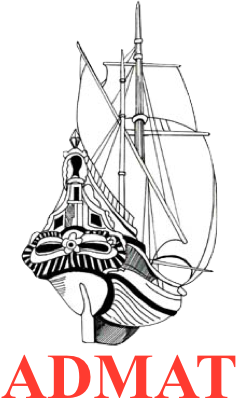ADMAT PRESS RELEASE
Indiana University & ADMAT Conduct Field School in Historic Isabela in the Dominican Republic.
Patrick Enlow, Dr. Simon Q. Spooner, Isabella and Christine Nielsen, with the anchor raised from in front of Isabela.
Mr. Charles Beeker, Director of Academic Diving and Underwater Science Programs, Dr. Geoffrey Conrad, Director of the Mathers Museum of World Cultures, from Indiana University (IU), and Dr. Simon Spooner from the Anglo~Danish Maritime Archaeological Team (ADMAT) have just completed phase 1 of a geophysical maritime field school survey in La Isabela Bay, the location of the first settlement in the New World built by Christopher Columbus on the north coast of the Dominican Republic.
IU professors, graduate, and undergraduate students worked together with ADMAT who provided the logistical maritime archaeological support and training. The survey was conducted in collaboration with the Oficina Nacional De Patrimonio Cultural Subacuàtico (ONPCS), with Technical Director Francis Soto participating. ADMAT within 15 minutes of starting a geophysical survey, found a possible Columbus era kedge anchor, as well as located many proton magnetometer targets that may be associated with the sinking of one of the Columbus’s ships lost in the bay during a hurricane in June of 1495.
Dr. Spooner stated that “This settlement is the most important in the Americas, as it is from here that the Americas were developed and the Spanish empire in the Caribbean started. Finding one of the lost ships belonging to the “Admiral” as Columbus is still known as in the Dominican Republic will be a major maritime archaeological discovery, which will yield much important information”.
Christopher Columbus departed Spain September 25, 1493, on his second voyage to the New World, with 17 assorted vessels and over 1200 men in an attempt to establish a permanent Spanish colony. His destination was La Navidad, off the north coast of Haiti, where, during his first voyage, he had left 39 men in a fortress built from the wreckage of the Santa Maria. Arriving nearly two months later, on November 28, 1493, Columbus found the makeshift fortress burned and all his men dead. Determining the area unsuitable for a permanent colony, Columbus and his fleet departed La Navidad December 6, 1493, sailing east along the coast of Hispaniola. Beating against the prevailing easterly winds for almost a month, on January 2nd, 1494, Columbus landed at a bay he had noted in his log during his first voyage. For reasons only known to him, he established La Isabela on the north coast of what is now the Dominican Republic.
At the time Isabela Bay provided relatively secure anchorage, fresh water from the Rio Bajabonico, a nearby delta plain for agriculture, and an elevated 15 foot limestone marl vantage point as a site to build a walled fortress overlooking the bay. However, Isabela soon proved to be unsuitable for habitation. The settlement was subject to deadly diseases, two devastating hurricanes, and an open roadstead anchorage which was unprotected from winter winds and swells. By order of the Spanish crown, a new permanent settlement was established near the south shore of Hispaniola on the west bank of the Ozama river, the current location of Santo Domingo. By 1498, Isabela was totally abandoned.
During Isabela's short occupation several ships were lost. The presence of these shipwrecks in Isabela Bay is documented by several primary sources. Researchers estimate that in total eight or nine vessels were lost at Isabela including at least four to six caravels and one to two larger store ships or naos. One of the naos lost in the first hurricane was the Mariagalante, Columbus's flagship on the second voyage.
Charles Beeker said: “The discovery of a Columbus shipwreck, let alone the finding of the Mariagalante, would be a tremendous contribution to maritime archaeology. However, perhaps more important, would be if the ship were laden with native Taino Indian artifacts destined for Spain. Such a find would shed a new light on the nature of the contact period between the Old and the New Worlds.”
According to Geoffrey Conrad, previous excavations in the ruins of the Spanish town have provided valuable information on the first sustained interactions between Europeans and American Indians. Nonetheless, Conrad said, “We’re still missing two big pieces of the puzzle at La Isabela—the shipwrecks and the Taino sites around the bay. Those pieces are what our project is all about.”
The IU and ADMAT team will be returning later this year to conduct excavations to ascertain which of the historic ships it has found.
For additional information contact:
Mr. Charles Beeker at 812-855-5748; cbeeker@indiana.edu
Dr. Geoffrey W. Conrad at 812-855-6066; conrad@indiana.edu
Dr. Simon Spooner at 1-809-579-3289; maritime_archaeology@yahoo.co.uk
Francis Soto at 1-809-685-9072; onpcs@codetel.net.do
End of Press Release

